Rex Peavine
--A Powerful Saddle Horse Sport Horse Sire--
Rex Peavine ASA (Saddle Horse), born in 1889, is still a genetic force in the modern Saddlebred horses that excel in Olympic style sport. He proved so strong a factor that in a dressage star I analyzed, Harry Callahan SB (Saddlebred), even though born 110 years later, I found the sheer volume of Rex Peavine lines in Harry reached forward to lead the genetics (28 lines in the 7th through 10th generation--critical mass.) I began this research by searching for Saddlebreds in Olympic style sport (jumping, dressage, eventing), and when I evaluated their pedigrees it became clear that Rex Peavine was a leading genetic contributor to their type and success.
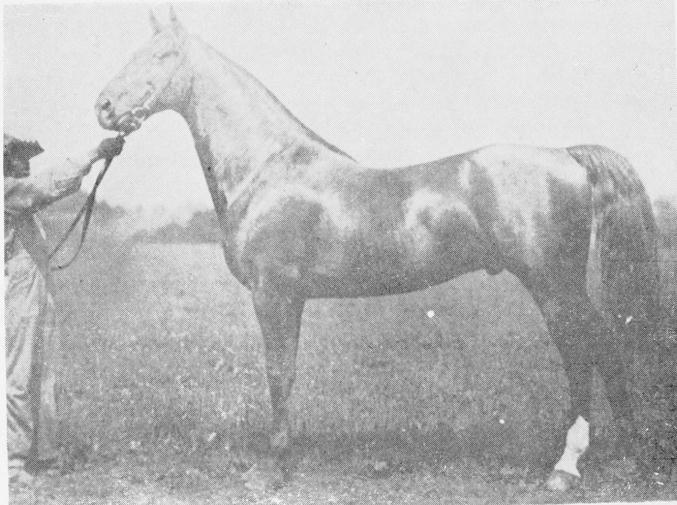
[Rex Peavine ASA 1889, a sire of excellence and a backbone of the breed.]
In other Saddlebreds I examined, such as the successful dressage sire Flight Time Gold SB 1984, Rex Peavine ASA, also led his genetics with 20 lines in the 5th-8th generation (read his story in North American Sport Horse Breeder); with the top Saddlebred sport sire Borealis SB, behind his front linebreeding are two core dominances: Rex Peavine ASA (54 lines) with a lesser but still powerful background in the trotter Harrison Chief AT (via Bourbon King and others). And I found in the modern eventing star, Giving You The Business SB 2005 (aka Arvo), there were 61 lines of Rex Peavine in the 8th-10th generation, again critical mass, surely this sire was a significant typesetter for the sport Saddlebred.
I also chose Rex Peavine to represent the Saddlebred sport bloodlines for another reason. By his date of birth, 1889, he becomes a window in the time before the show horse version of the breed entirely took over the breeding choices, as he was part of the age when the horse was the main source of transportation and had multiple uses. We have come so far from the roots of our native breeds, and they have become so specialized in our modern day, that we entirely miss what they are capable of and many are unaware of what top rate sport horses they really are and have always been. Few of us realize that our domestic breeds, like the Saddlebred, are completely made up of sport genetics, and we will see this total lack of knowledge demonstrated in how the modern stars mentioned above are described by the industry writers who reflect the historical fog that has settled on our industry about just where sport talent resides, and which breeds are indeed sport horses. Also 40 years of warmblood influences, with their narratives and government powered marketing, has helped the American equestrian become disconnected with their own equine history and the true components of their own breeds. (See American Sport Horse History for a discussion of the doublethink that has settled into our equestrian psyche).
This study is lengthier than I anticipated, but it is my hope if you can read through it, that the evidence provided will demonstrate clearly to you that the Saddlebred is a premier sport horse breed.
Overview of Breed Development
Kentucky, Tennessee and Missouri were centers of Saddle Horse development from the mid-1800s on, when those frontier areas became more settled and organized in breeding. The Civil War set all the breeding areas back, some more than others, but Kentucky rebounded very quickly, excelling in its galloping racer, Running Horses and Thoroughbreds, American Trotters and then Standardbred, and of course its fabulous saddle horses.
Most do not comprehend that our American Saddle Horse breed isn't just another name for the Saddlebred, and that the Saddle Horse actually began further east, and traveled with the settlers to these centers with the beginnings of the breed from approximately 1800 in Virginia. It was there the breed was created with clear breeding goals by breeders who were reacting to the negative effect excessive crossing of the new version of the English Thoroughbred (classic race version) was producing on our Running Horse stock. They instituted our first foundation movement to protect and restore the features they most valued. Visionary breeders such as John Goode, John Randolph and others in the Roanoke Valley area, decided to stop the spread of the Thoroughbred fad and save our native breed.
The Roanoke Valley breeders were situated further west from the Virginia centers (coastal) where the Thoroughbred had taken a strong hold, and they had been selectively breeding their strain for 150 years for speed with sprint races their performance test. Because of their geographical position they lost less stock in the Revolution then the coastal Virginia areas where Thoroughbred crossing was more common. so they had a reservoir of their potent product, noted for speed, celebrated for its use as saddle horses, and surprisingly possessing extreme amounts of stamina as well. The cross of the Thoroughbred earlier (Janus, Fearnought etc) had brought favorable results, but by the turn of the century the English breed had changed (see Thoroughbred and Soundness for possible reasons) and the cross was bringing a notable lack of speed, along with weak hooves, flighty and sometimes vicious temperament, long backs and the vice of stumbling. They set apart three stallions that had the right characteristics (Goodes Twigg RH, Bedford TB, Roebuck RH) to cross on the Roanoke Valley stock. One of the by-products of this foundation movement was the establishment of the 'Plantation Horse', which became known later as the American Saddle Horse. (MacKay-Smith, Colonial Quarter Race Horse).
After consulting the Saddle Horse histories by Farschler, Susanne, Ranson and Womack (Tennessee Walker), I came away impressed by how excellent the references they created were, but also it was clear that the deeper roots of the breed were somewhat unknown or confused; for example, I found important foundation horses of Virginia, Maryland, Canada, Vermont were often miss-identified. In looking at this we must remember Kentucky-Tennessee-Missouri were the frontier in 1800, and the earliest stock was often not recorded until later on, or not at all. Plus the true heritage of certain horses was lost, or not known at that time, indeed, some of the background information on these foundation horses have just come to light in our day. The histories presented in the references seem to become more accurate after the Civil War (see Standardbred Sport Horses for a detailed breed development history).
In Virginia, which had been breeding horses of excellence since 1611, and had created our first domestic racehorse breed (56 to 60 years before Narragansett Pacer), found by 1668 that it was so overrun with horses, that they needed to pass legislation banning importation of horses from anywhere. And a hundred years later because of gambling excesses they began (by 1792) successive waves of laws restricting the racing industry. The racing industry was hurt, and breeders suffered loss of income, but the added regulations also coincided with the westward expansion beyond the Appalachian Mountains (areas that became Tennessee, Kentucky, then Missouri etc.), and so it was that much of the potent Virginia stock made its way there.
On the frontier record keeping was spotty at first, so that many of the Janus crosses and the Hiatoga RH progeny, for example, went unrecorded. But by 1810 or so we find stud advertisements and recordings becoming more common. The northern or Canadian stock started showing up a little later, Copperbottom RH for instance, coming to the area after the 1812 War with Captain Jewett, and he was miss-identified as a Canadian because that is where Jewett bought him; and it took until 1909, a hundred years later after his birth to uncover his true history (son of Figure RH out of a Narragansett Mare, born in Danville, Vermont and taken to Canada as a yearling.) (Battell American Stallion Register vol. 1 1909).
Because of my quest to trace sport and speed traits back through time to their roots, I discovered many of common industry narratives on breed identification and establishment dates are inaccurate, even specific horses and breed labels are often wrong (see Outline of North American Breed Development). But I also found that most of our domestic breeds are closely related, often springing from common bloodlines, and all of them are entirely sport bred; always used for racing and hunting as well as saddle use. The colonial stock they sprung from, imported Irish Hobbies and English Running Horses, were sport bred for centuries in Ireland and England before they arrived in our colonies. (See American Running Horse for the documentation of this). In contrast, the horses of the Continent, began as heavy draft, farm stock and utility horses, and then had to add generations of Thoroughbred and Trotter before they could be competitive in sport.
So, what does this have to do with the Saddlebred? The Saddlebred arose from those same key bloodlines that birthed the American Trotter (later Standardbred), Pacing Running Horse, Morgan, American Running Horse (later American Thoroughbred), and our other saddle breeds. No matter which of the original traits of the Running Horse the breeders of each population selected for, behind it all is the horse that could run, pace, jump, was fast and had incredible stamina. That is why, after 100 years of selective breeding largely just for show ring saddle traits, that the Saddlebred, when tested in other sport venues comes out a winner. It did not lose its sport bloodlines--they are still there and potent, and I will demonstrate that happy fact with this study.
The Saddlebred is a natural sport horse, with far more sport genetics then found in the imported breeds that many paid so much for, and then often discovered they were unsound or could not reach the athletic heights advertised. It is ironic that all the while, during the warmblood fad, that we had the very breeds that can excel in Olympic style sport right here, but we had already become blinded before the warmblood invasion by the 50 years of restricted show ring use, and then this combined with our overall lack of knowledge of what our breeds are made of, then we became incapable of understanding or recognizing sport talent in our breeds.
Foundation Stock
Let me list a few of the key foundation sires that arrived early in Kentucky and created their top rated saddle, trotter and racer, and spread from there to the surrounding areas.
Janus TB (1746-1780) descendants, many horses were inbred to him, few of the early ones were recorded, but we know Blackburns Whip RH 1805, a pacer, four-mile-heat racer, speed source, that he is inbred 4x4x5 to Janus and 4x4x5 to Brandon RH, and his sire Whip is a typical TB of the day, Herod and Eclipse lines; he stood in Kentucky from 1816-1828. Another of the Janus line is Printer RH 1795, a great sprinter who became a foundation of the Quarter Horse and he left stock in Kentucky as well. Cockspur RH, a Virginia bred pacing racer was said to be grandson of Janus TB and Sir Archy TB (Diomed line), and his descendants including Gaines Denmark ASA 1851. The line of Diomed TB is just as important as Janus in our native breeds, and in most of those horses you will find carry Diomed as well.
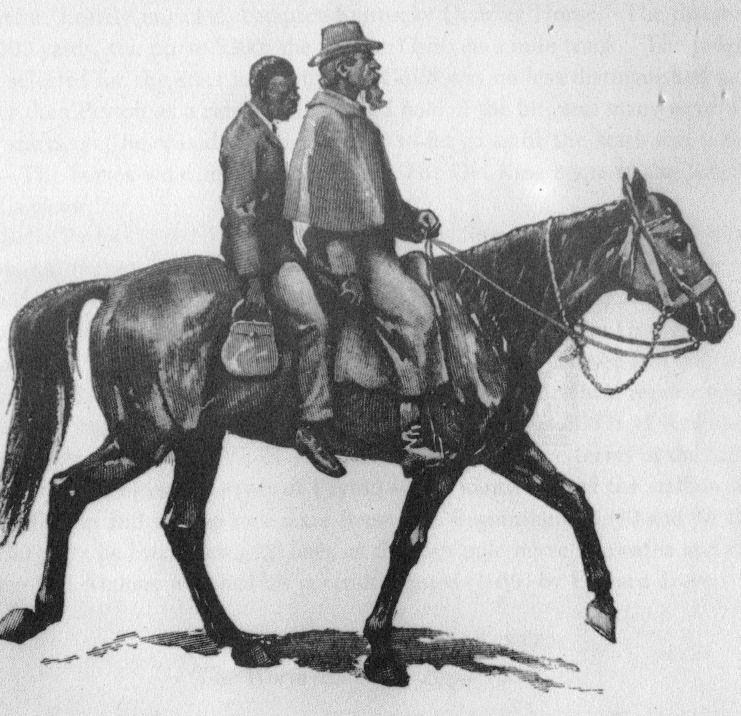
[Kentucky Saddler around 1890, on the way to a hunt, moving in a comfortable running walk---Max Keppler artist]
Other key foundations are Copperbottom RH 1809 who we discussed above was a son of Figure RH 1789 (foundation sire of the Morgan), plus other Figure RH offspring such as Black Hawk MO 1833. And Old Pacing Pilot RH 1823, bred in Canada, a foundation of the later Canadian Pacer, was sold to the States and he left excellent stock throughout our saddle regions including the important sires Brown Pilot RH and Pilot Jr. AT. Later his close relative Davy Crockett CP 1833, a true Canadian Pacer, made strong saddle lines such as Brinkers Drennon ASA. Many pacers that were born before the creation of the Canadian Pacer (approximately 1830) were later referred to as 'canadian pacers', I believe it was sort of a slang term, like calling a vacuum cleaner a Hoover, and then many were added into the later stud book (1891) as such, with the people of the day taking the term as literal, thereby confusing generations of later breeders. A similar thing happened with the slang term 'arabian' slapped on English studbook entries when they needed to demonstrate oriental descent to qualify, and then later people took it literally. For example, Tom Hal RH 1805, long miss-identified as a Canadian Pacer (breed didn't exist then, and he was born in Maryland), became a strong line in all our saddle horse breeds; his son Bald Stockings RH 1837 out of a Copperbottom mare (a foundation sire of the Tennessee Walker) is found in most of our saddle horses and is powerful in the Standardbred. (For full story of the migration of our talented stock and breed development see Standardbred Sport Horses and American Running Horse).
The American Saddle Horse is the parent breed of the Saddlebred, Tennessee Walker and Missouri Fox Trotter; this means the Saddlebred, which is the Kentucky based strain, is just one branch of this breed. The studbook was not made until 1891, and it was later retained by the Kentucky breeders when the Tennessee breeders broke away and created their own studbook in 1935, causing some disconnect with their heritage. The Kentucky breeders were very powerful and organized, and as early as 1908 they were adjusting the studbook foundations to more suit their own strain then the others, until finally they settled on just Gaines Denmark ASA being 'the' foundation sire. This left out the Tennessee branch, whose strain, while certainly had Gaines Denmark ASA in it was more based on the genetics of Bald Stockings RH who is also found in the Saddlebred foundations.
Even early on the Tennessee breeders referred to their breed as the Plantation Horse, while the Kentucky breeders often called theirs the Kentucky Saddler. Plus the breed standards were not in agreement, with Tennessee wanting their own brand of running walk and its rocking chair canter as breed requirements (see "The Versatile Tennessee Walker'), and in Missouri they decided to specialize in a fox trot. Kentucky wanted a good running walk or rack, but also a clear trot. So the three branches developed in slightly different directions, plus the Kentucky breeders, led by John Castleman, wanted to cross in much Thoroughbred to produce what he called 'finish'. Be that as it may, if you extend the pedigrees it becomes clear the bloodlines in the background of all of them are more the same then different. More specialization occurred after the Civil War, as Tennessee, being part of the Confederacy, suffered greatly with their horse industry almost destroyed, while Kentucky fared better, with more preserved to breed on with as it part of the Union.
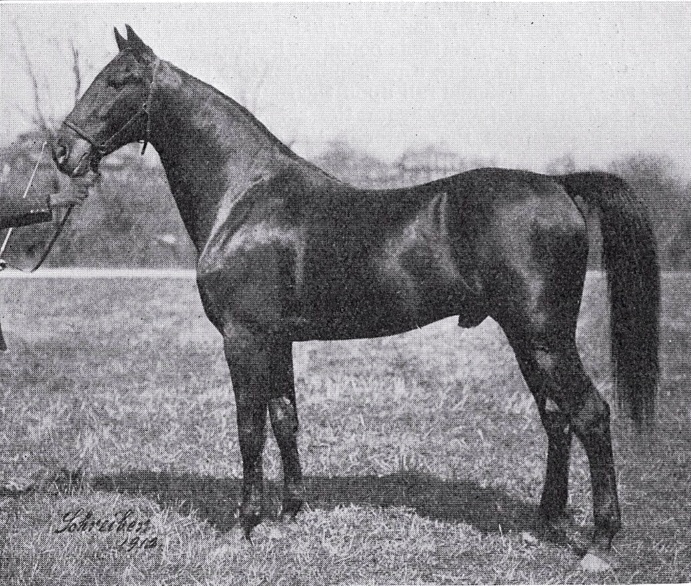
[An American Saddle Horse stallion used by the Remount in 1912, showing the excellent conformation, strong legs and feet, and the balance that are innate in the breed. This stallion was not identified (government photo), but he looks a lot like Rex Peavine and may very well be one of his sons.]
Most sport horse competitors and breeders never give the American breeds a second thought in pursuit of their sport horse goals; they are blind to what is right there in front of them. How could this happen? I think I have a partial answer for this. Flipping through the various references I have and looking at the turn out of the horses it became clear that sometime around World War I the show ring performance became slanted to flashy presentation, rather than a tool to gauge the overall value of the horse--a case of the performance test becoming the goal. I may be wrong in this, but it is the impression I got from my research into this transformation from a top sport saddle horse to a show specialist. It was around that time I first noticed the artificial tail-set...that upright tail that in our day is usually achieved by surgery was at first mechanically splinted. Why else would someone deform a beautiful horse then to achieve a goal of making it more exciting in the show ring? It certainly doesn't aid a hunter or a jumper to have a set tail does it?
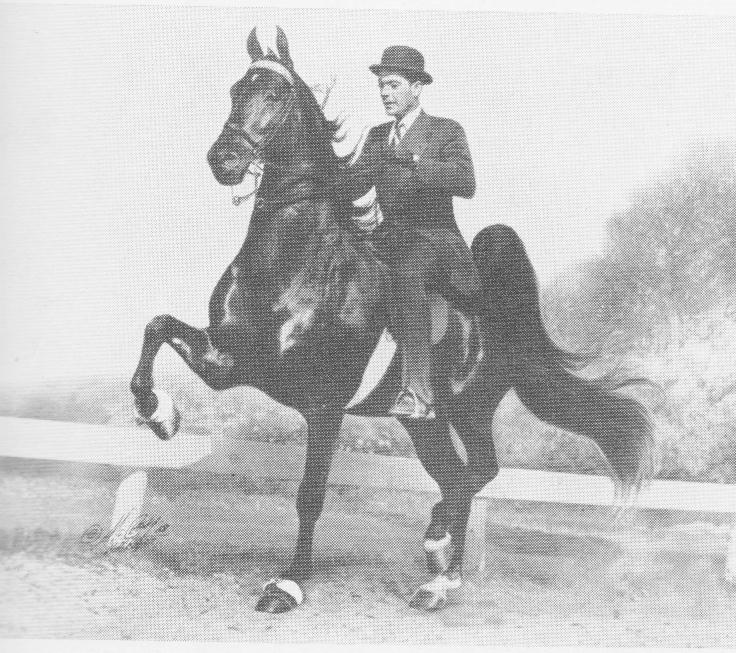
[American Saddlebred stallion in 1938, in full turn out for the 5-gaited competitions...notice the set tail, the exaggerated leg movement, and the weighted shoes with weighted coronet rolls...all designed to add flamboyance to the performance.]
After the invention of motorized vehicles the many transportation uses of our horses decreased, and by the mid-20th century team sports started to overtake ridden sports as a favorite pastime. It appears then that the premier hunter and cross country horse, was fully shifted into a show ring performer. The versatile talents of the American Saddle Horse , and its descendant breeds, became less and less used as the breed became a show ring specialist, until in our day most equestrians (many of them born after all this occurred) are unaware of the sport abilities our domestic breeds contain---they have no memory of those great sport horses.
Rex Peavine 1889
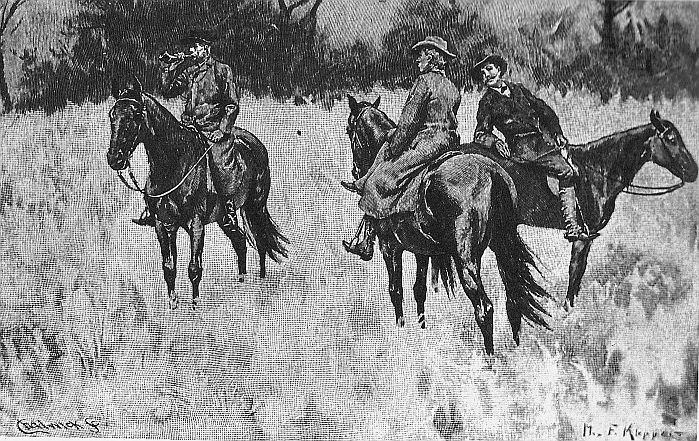
At the time of Rex Peavine's birth (1889) the Saddle Horse was the preferred mode of individual transportation, and was still used in light harness, although the Trotters had taken over some of the harness duties, and the Saddle Horse was the preferred mount for the much enjoyed recreation of the hunt. The Saddle Horse was always a good jumper, and a tough and stamina filled cross country horse.
Bred by Dr. Hockaday, Rex Peavine's type was considered a little coarse, more masculine looking then refined, but when he moved few could match him. He was a very good 5-gaited show horse, but his real fame came from his tremendous stud success.
"No Saddlebred stallion in many years prior to him earned the world-wide fame at stud, as Rex Peavine did. His success as a sire was as immediate as the instant success of his progeny, while other stallions of this time who were more highly rated a show horses failed to "breed on" at stud. He retained his reputation and popularity for over twenty years, with his fees constantly rising and even turned mares away at high prices." ( Patricia Crane www.artbycrane.com).
Most articles and sections recalling his stud career say his daughters were better than his sons. And when you consider such greats as Edna May and Hazel Dawn, you can see why they were so impressed. But then I considered his sons, great show geldings like Mass of Gold and Rexall Prince, and fantastic breed shaping stallions like Kalarama Rex and Jean Val Jean, and then I didn't see as much difference in quality, instead it seems to me he was a great stallion all around.
So, let's see what made him so powerfully potent. You will see 'ASA' after his name and that of many of his ancestors, this is my breed abbreviation for American Saddle Horse, for Saddlebred I use SB (see American Breed Development).
His pedigree has an 'engine room' roaring with activity (engine room: 4th to 6th generation). Not as easy to see as the colored duplication but is an important configuration, the background power generated in the engine room and beyond is concentrated and pulled forward through the 3/4 brothers: Black Eagle and Stonewall Jackson 4x3 which compounds the concentration (6x5x6x6) of the full brothers Sir Charles RH/Marion RH (by Sir Archy TB out of Citizen Mare RH), who are 4-mile heat racers. Pedigree patterns like this demonstrate typesetting strength potency- this is a tough stamina loaded genotype.
[Note: in online databases you may see different breed identifications (example Rex Peavine at All Breed Pedigree) where you will see Rex and almost all his ancestors listed as Saddlebred, which as far as I can tell, did not become a separate breed from the Tennessee Walker branch until 1935, but look also at the damsire Peavine--who had a career first as a trotting racer and later became a winning show horse; his sire Rattler is listed as a Standardbred, yet he was born in 1854...the Standardbred did not become a breed until the 2:30 mile standard was set in 1879, before that the horses were American Trotters, and his dam Pekina born in 1844, is listed as a Thoroughbred, and the American Thoroughbred did not become a breed until 1868, and Pekina was a gaited saddle horse not a racehorse. Plus, to be a legitimate Thoroughbred in her day she had to be a GSB registered Thoroughbred (General Stud Book) with 5 full generations of GSB registered ancestors...she is not even close to either of those requirements in any way, and her second damsire is a pacing Running Horse, Blackburns Whip RH, yet he too is listed as a Thoroughbred. To me this is crazy, or maybe it is just plain lazy, I can't tell, why would you slap a breed label on a horse that was born before the breed began? Yet, this seems to be the new way of entering pedigrees, and it is wrong, not just because it drives me nuts, but because it denies the breeders of the era their due, and it does not respect their intentions, and it distorts history.]
Rex Peavine has three strong genetic dominances and a few other secondary ones that set his type and ability. These are the background genetics that by quantity of lines overpower the genetic weight of closer horses. First, he carries Black Hawk MO 6x7x8x6x5, a very close second in strength is Gaines Denmark ASA 7x5x5 and third, Sir Archy TB with 10 lines sex-balanced. The secondary dominances are Blackburns Whip RH 6x7 and Cockspur RH 9x8x7x6x7. (You will also see significant lines of Bald Stockings RH and Grey Eagle RH).
The lines of Black Hawk MO and Gaines Denmark ASA are by sons only, but are given a 'remote sex balance' by the lines of Cockspure RH and Blackburns Whip RH which are both present by daughters only. Also Gaines Denmark ASA is brought forward by the 3/4 brothers through both a son and a daughter---so a sex-balanced transmission. There are several areas of Rex Peavine's pedigree that end with 'unrecorded' and so while most of his ancestry is known, often it is the damlines that are missing, which means we can't see the full genetic impact of the marelines. Because it was pointed out that his daughters were fantastic, I can only assume that what we don't see in the unrecorded lines may hold the key to understanding fully the feminine power he passed on.
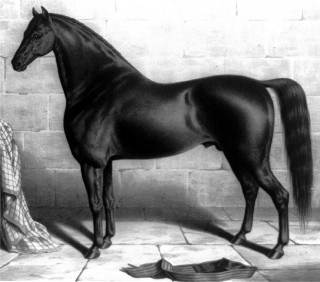
[The magnificent Black Hawk MO, born 1833]
To understand the talents latent in the Saddlebred, you have only to know about these typesetting ancestors, because these are the genetics that are being 'channeled' forward, setting the type and abilities in the stock. Pay attention now, because this pedigree information is key to why Rex Peavine ASA is such a good sire and why his line is still powering champions.
Black Hawk MO was the greatest Morgan trotter of his day, very fast, with incredible stamina, able to trot 20 miles without breathing hard, and with such beauty and style he mesmerized his observers. He was absolutely beautiful, shiny jet black, compact muscular build, perfect legs and feet, strong hind quarter, magnificient shoulder and head set. And as a sire he should be rated in with the greatest sires of all time for any breed...because his bloodlines are the backbone of not just the Morgan, but the Saddlebred, Tennessee Walker, Missouri Fox Trotter, Quarter Horse and Standardbred. He passed on his type so reliably that stockmen could just look at a horse and recognize that it was a 'black hawk'.
The second strongest influence is Gaines Denmark ASA, and besides being the perfect saddle horse (and like all his breed he was used as a hunter), he was lauded for his cavalry duty when ridden by General John Hunt Morgan during the Civil War. You realize of course that any horse that can be a top cavalry charger can also succeeded at cross country sports---the criteria are the same.
Emily Ellen Sharf (aka Susanne) in volume II of Famous Saddle Horses, lists four attributes that set Gaines Denmark above his contemporaries; one, that he was incredibly beautiful; two, that he was a talented 5-gaited performer; three, that he was an extremely potent typesetter; four, that he was the true foundation sire of the modern Saddlebred.
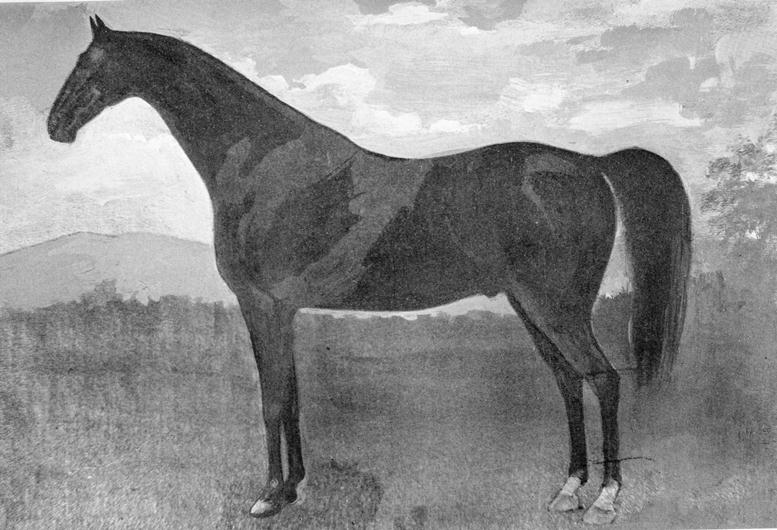
[Gaines Denmark ASA in a damaged oil painting from the Gaines estate.]
John Castleman, who served as a Brigadier General in the Confederacy (Civil War 1860-1865), and later became the president of the American Saddle Horse Association, had this to say about the excellence of the saddle horse as a cavalry mount:
"The history of cavalry service shows no parallel to the continuous fast movement of the cavalry under Morgan and Forrest, and this service as rendered chiefly by the American saddle-bred horse; and this horse of singular beauty and smooth, fast walk and untiring energy stood the terrible strain where horses of other breeds gave way under test of great marches...The saddle-bred horse is very valuable for cavalry service, because of other reasons then merely his superior powers of endurance. His smooth action and easier gaits render the march less fatiguing to the rider; he succumbs less readily to privations and exposure, and responds more cheerfully to kind and careful treatment. He acquires more promptly and perfectly the drill and habits of the camp and march, and his intelligence and courage make him more reliable on the field." (American Saddle Horse Register 1911, p. xxiv-xxv)
The Saddlebred retained many of the talents of their parent breed as demonstrated later on between 1910-1950, when our Remount program used their mares and stallions (along with Thoroughbred, Standardbred and Morgan), and more than a few Saddlebreds or part-Saddlebreds made their way onto the Army Equestrian Team, including the international show jumper Joe Ashire, a half-Saddlebred.
The third most dominant genetic player in Rex Peavine ASA is Sir Archy TB, a domestically bred full Thoroughbred (1802) born before there was an American Thoroughbred breed. A premier 4-mile heat racer of his day and at stud his record was fantastic, even close inbreeding to him produced great horses. Here are a few: the incomparable 4-mile heat racer and stud Lexington RH 1850 was 3x4 to Sir Archy TB; the famous quarter racing mare Bonnets O' Blue RH 1827 was 2x2 to Sir Archy TB; and the champion 4-mile heat racer Trifle RH 1828 was 2x3 to Sir Archy TB.
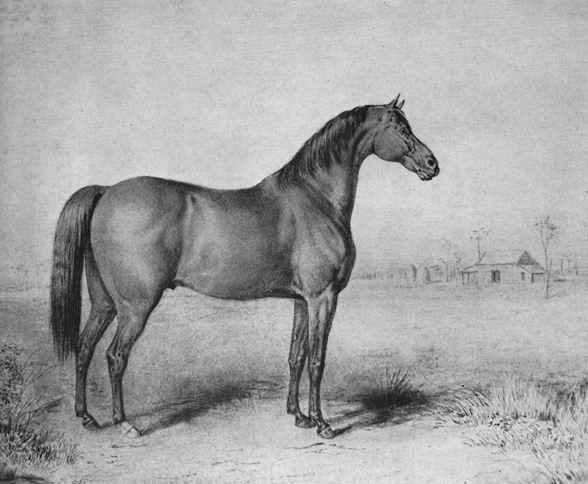
[Sir Archy TB 1802}
So here you have the most potent genetics in Rex Peavine, and did you notice the quality of these sires? Each was the very best in his field and at stud in his day: Black Hawk MO in trotting, Gaines Denmark ASA show saddle horse and cavalry horse, and Sir Archy TB in heat racing. These sires are the cream of sport ability and talent---it gets no better than these sires.
His slightly lesser power lines: Blackburns Whip RH 1805, a pacing racer from the Roanoke Valley, who could also trot and gallop, and all of his gaits were perfect, and he too could win in 4-mile heat racing; he possessed tremendous amounts of stamina and speed, and could pass it all on. He was such a great sire and sure transmitter of speed he is found not just in our Saddle Horses, Quarter Horses, and in the Standardbred, but he is also found in the Thoroughbred, where he can be seen in Parole, the horse that gave the invincible Isonomy his first defeat, and in Nearco. Bet you didn't know that the 'sire of the century' Nearco has a pacing Running Horse in his dam quadrant. And Cockspur RH, another Virginia bred pacer, whose genetics gave Gaines Denmark ASA and his best son Washington Denmark ASA their famous movement (Sharf).
When someone steps out of using the Saddlebred in the usual modern show ring version, and tries it in Olympic style sport---like the 4 examples I will give below, they easily demonstrate the true sport genetics that they carry.
Four Modern Sport Saddlebreds
Flight Time Gold SB--dressage sire
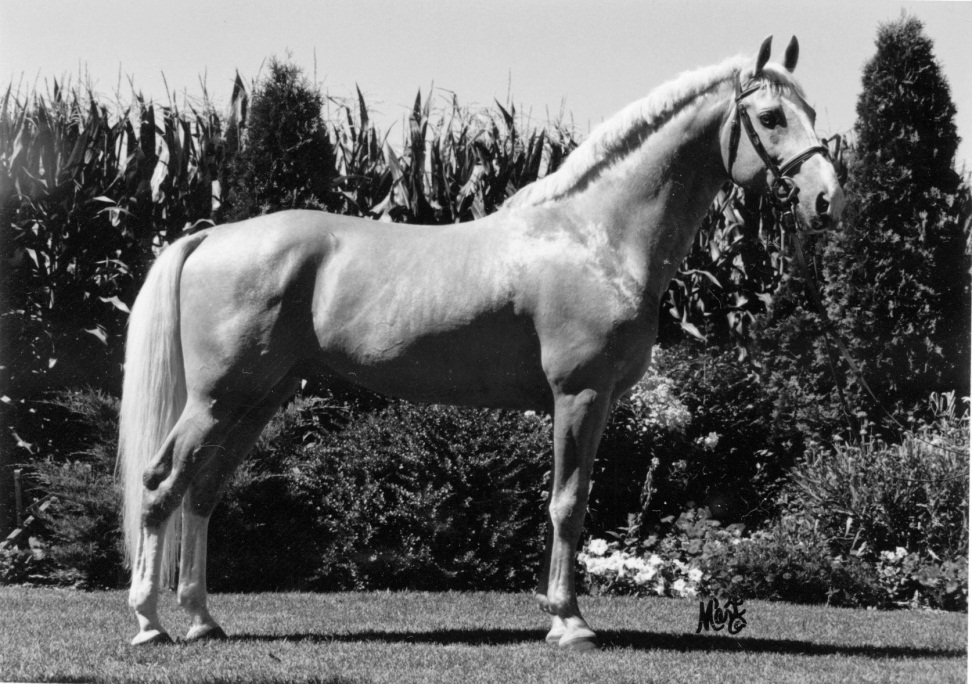
[Flight Time Gold SB 1984, is a horse that I gave a chapter to in my first book, North American Sport Horse Breeder. Photo by Works M'Art]
The story of Flight Time Gold SB (pedigree) was generously shared by his first owner Teri Duewer, and then his later owners Michael Wakefield and Michele Binder. Their observations I believe are very helpful for those of you who are looking for your next sport horse or sire. When Teri acquired Flight as an untrained 9 year old in the 1990s, the warmblood fad was heating up in this country. Teri was a visionary but she was way ahead of her time, and as successful a sport horse sire as he proved to be, buyers and competitors were not ready to consider a non-European sport horse. She bought him to begin breeding dressage horses, and her judgment proved correct, for his progeny made him the leading American Warmblood stallion in rankings. This was against odds, because of an old injury he could not have a real performance career, and then he proved sub-fertile at stud, and so was only a live-cover stallion. Despite all that his offspring won just about everything they entered. They excelled in dressage, and he consistently passed on great athleticism, perfect conformation, great legs and feet, sweet disposition and great beauty.
Later on, Flight was leased and then sold to Michael Wakefield and Michele Binder, and these sport horse breeders tried him on a variety of breeds.They reported that he improved consistently whatever he was crossed on. With Holstein mares he improved collection and lightness in gaits and added his calm temperament. Crossed on Thoroughbreds he improved collection and rideability, on driving horses he improved the legs and feet, gave a clean balanced trot, and with jumpers he corrected gaits to strong, clear and with suspension.
Flight's greatest dominances as mentioned at top of the article are Rex Peavine ASA (20 lines in 5th-8th generation--critical mass). Read Flight's story in North American Sport Horse Breeder. The next closest dominance is in Bourbon King ASA with 16 lines in 6th-9th generation. Bourbon King, like Rex Peavine, is a standard presence in the Saddlebred, found in multiples more often then not. Bourbon King ASA 1900 (pedigree) is a Harrison Chief AT genetic bomb, 2x3, through sons, a very male leaning pedigree, but also has many unknown sections. It is interesting that Harrison Chief's damline goes straight back to the start of the saddle horse beginning with a Bedford TB daughter. Bedford was an early imported English Thoroughbred whose progeny were noted not so much for racing as for consistent being excellent gaited saddle horses.
Harry Callahan SB 1998 --Grand Prix dressage
Harry Callahan SB (pedigree) was a dressage star, winning up to Grand Prix level in open competitions. Bought by Lisa Cawthorn as a untrained 3-year-old to fulfill her dream of a Saddlebred excelling in dressage; he was sent to Chrissa Hoffman for training. By the time he was 6 Chrissa had him at 3rd level and he was such a remarkable performer he was featured on the cover of USDF Connection. By 10 Harry had entered Grand Prix level. ("Unorthodox Excellence, pt.1: Harry Callahan, Grand Prix dressage Saddlebred" Horsenation.com 6/17/2013) Harry's strongest genetic influence is his 28 lines of Rex Peavine in the 7th through 10th generation.
Notice the Saddlebred is viewed by the industry as an 'unorthodox' breed for the dressage discipline. This attitude should set off a alarms in American breeders, that a psy-op is underway. How could a premier saddle horse, celebrated for its smooth correct gaits, not be a candidate for dressage? Its a con job folks.
Borealis SB 2001- top sire of dressage horses
Borealis SB (pedigree) was another Saddlebred stallion used in sport horse breeding, winning the breeding class at Dressage at Devon two years running (reminiscent of Flight Time Gold above). (Read about Borealis on this link). His owner, Julie Lynn Andrews (visit her information site), is another visionary Saddlebred breeder who realized and promoted the sport horse potential in the breed. She bought Borealis to Dressage at Devon, and won the breeders class two years running.
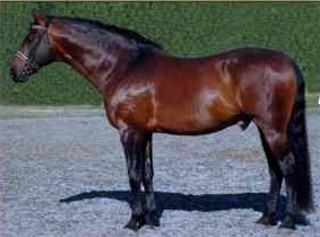
[Borealis conformation shot]
Borealis is different in that his front inbreeding to Supreme Sultan and his full brother Super Supreme 3x4x4 leads the genetics, this is a very potent design, and the full brothers are the front focal point for the background power of 44 lines of Bourbon King and 54 lines of Rex Peavine --very strong typesetting. He also carries other genetic strengths in Tom Hal RH and Gaines Denmark ASA.
Giving You the Business 2005--champion eventer
Another gelding, Giving You the Business SB, aka Arvo, was a champion eventer (pedigree). We saw above how suitable the Saddlebred is in dressage, but the Saddlebred is not a one discipline breed.
Lisa Bauman bought Giving You the Business SB, commonly called Arvo, as a weanling to use as an event horse. Lisa evidently understood the breed well, because eventing is the sport that arose from the cavalry tests, and what was the perfect cavalry horse of the Civil War? Yes, it was our Saddle Horse. Arvo did not disappoint her--he was a natural cross country star. Lisa reports: "cross country is so nonchalant for him; he was just so impressive."
Sally Spickard, who wrote the Horse Nation article: "Eventing Nation: A Saddlebred Event Horse?", like most in our industry has no idea what are native breeds really are. Sally however, reported something you may find interesting that Lisa had mentioned:
"As a 2-year-old, Arvo displayed his jumping prowess by jumping from one arena into another from a standstill."
Here we have again evidence of the enduring sport talents our Saddle Horses received from their ancestors. When John Fox Jr. in 1895 (Rex Peavine's era) related the abilities of the Saddle Horse in the hunt field, he wrote about one of the traits he admired:
"His horse, when he jumps at all, does not take fences in his stride, but standing. And I have yet to see anything more graceful then the slow rise, the calculating poise, the leap wholly from the hindfeet, and the quick, high gather to clear the fence. It is not impossible to find a horse that will feel for the top rail with his knees, and if they are not high enough, he will lift them higher before making his leap."
This witnessed extreme ability to collect and launch a jump from a standstill was noticed by others in the parent breeds of our Saddle Horses. The Canadian Pacer (Morgan and Narragansett genetics) and our original Running Horse strains from Virginia were always known as excellent hunt horses, able to clear obstacles with ease. In 1836, Chasseur reports about these hunt horses in Canada:
"As the country presents only timber of a very unyielding nature and stone walls, our horses are excellent fencers, and many sportsmen from your side, have been struck with their extraordinary qualities in this respect...The Canadian hunter is as good a standing as flying jumper, and it is absolutely requisite that he should be; for, in some of our thickly-wooded courses, it is impossible to run at the leap. ("Fox Hunting in Canada" Chasseur 1836).
The Canadian hunter of Chasseur's day was the Running Horse, early Morgan and the new Canadian Pacer breed-- a breed built from the Morgan/Narragansett cross. Thoroughbreds did not arrive in Canada until 1867 ( Smith 1931). Let that sink in...these horses were our native sport horse breed, direct descendants of the colonial imports of Irish Hobby and English Running Horse.
Arvo's main genetic dominance, like Borealis, has shifted to the more recent lines, in his case he carries 6 lines of the great Wing Commander, and he is the focal point for the background power of 49 lines of Bourbon King (7-10th generation) and 61 lines of Rex Peavine (7th-10th generation).
America's domestic breeds are sport bred from the tip of their ears to the bottom of their hooves. In the Saddle Horse, very seldom did any non-sport genetics enter the gene pool. Most have some English Thoroughbred, but our breeds did not have to add Thoroughbred to become 'sporty', they already were racers, hunters and saddle horses of excellence. The roots of our breeds began in 1611,which is 120 years before the first Thoroughbred reached our shores and really 140 years before any TB typesetter of significance was added. Our Running Horse arose from the same mare base as the English Thoroughbred. (see American Running Horse)
Our domestic breeds are pure sport horse, they need not have a separate stud book section for breeding for Olympic style sport as some in the industry have suggested. Unlike other populations of horse that began with a draft or farm or utility base and then added Thoroughbred and Trotter for generations to transform their stock to sporthorses, the American breeds are already the right stuff, perfect to use as is or in crosses.
(See Standardbred Sport Horses and American Running Horse for a detained account of our early stock and the breeds it spawned (Morgan, Canadian Pacer, Saddle Horse, American Trotter--Standardbred).
Pedigrees
Links
American Breed Development
The Versatile Tennessee Walker
Reference
American Saddle Horse Register 1911
Battell, Joseph American Stallion Register vol. 1, 1909
Chasseur "Fox Hunting in Canada" 1836
Crane, Patricia " Rex Peavine" www.artbycrane.com
Engle, Fred Allen "Rex Peavine was one of the greatest sires ever" 1981
Farschler, Earl F. The American Saddle Horse 1938
Fox, John Jr. "Kentucky Fox Hunt" 1895
Horsenation.com "Unorthodox Excellence, Pt. 1: Harry Callahan, Grand Prix dressage Saddlebred" 6/17/2013
"Eventing Nation: A Saddlebred Event Horse?" 2/12/2014
Kirsan, Kathleen North American Sport Horse Breeder 2013, Standardbred Sport Horses 2017, American Running Horse - a forgotten breed 2023
www.sport-horse-breeder.com: "Understanding Pedigrees, "Pedigree Generation Position", "American Breed Development", "American Running Horse series", "Borealis", "Origin of Sport Ability", "American Sport History", "Top Sires series", "The Versatile Tennessee Walker", "Thoroughbred and Soundness", "Saddlebred"
MacKay-Smith, Alexander Colonial Quarter Race Horse 1983
Ranson, J.H. History of the American Saddle Horse 1962
Scharf, Emily Ellen (aka Susanne) Famous Saddle Horses vol. 1&11 (1932 & 1942)
Smith, Harry Worcester "Steeplechasing in Canada" 1931
Womack, Bob The Echo of Hoofbeats 3rd edition, 1994